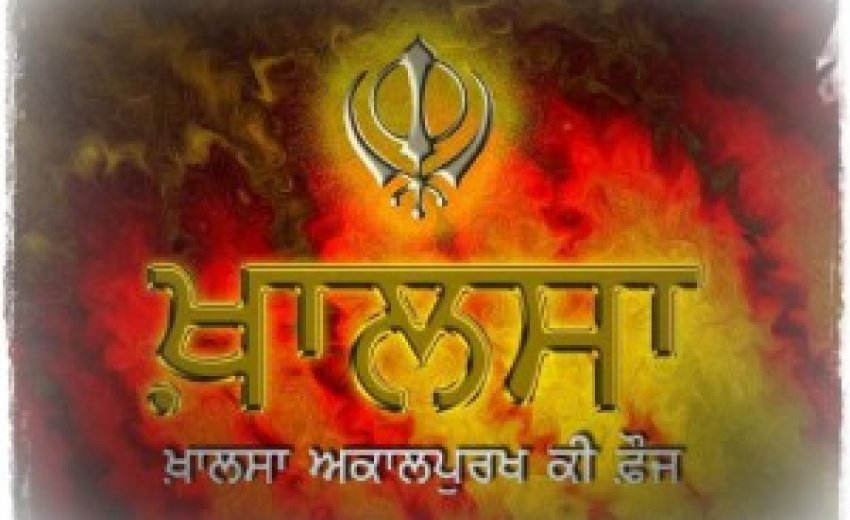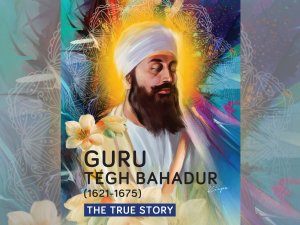Relevance of the Khalsa Today
 |
| Click to see in its entirety |
He revealed his vision and mission for the New Age. His mission, as it unfolded over the next two centuries guided by the same Guru Jyot (Guiding Light) in 10 Guru-persons to 1708, laid the foundation for the Order of the Khalsa, the Khalsa Panth.
There were three stages of Guru Nanak's mission: firstly to contemplate on the qualities of the Creator Being; secondly to interpret these qualities to reveal a God-centred being, the Khalsaiii; and thirdly, to show the temporal-spiritual (miri-piri) path of social activism for the Khalsa to follow.
Guru Nanak meditated on the qualities of the Creator Being and described them as:
The ONE, all-pervasive Creator of all universes, with eternal virtues, who does not fear or favor any one/thing, is not against any one, is the embodiment of timeless-ness and deathless-ness, does not take physical life form/does not incarnate, is self-existent; may be known with the guru's grace/guidance.iv
Khalsa is a manifestation of certain God qualities through God-centred beings. The Khalsa is revealed when the illusion between the Creator Being, His creation and His true devotee is removed. The Guru and His Sikh as the Khalsa, become one and the same. Serving God and His creation becomes the pre-condition for reaching God's holy presence v
Thus, like the sculptor who reveals the beautifully proportioned statue from a solid block by chipping away the bits which conceal it, the Khalsa was finally revealed (pragteo Khalsa) by Guru Nanak in His tenth human form as Guru Gobind Singh (1666-1708) on the Vaisakhi Day in 1699. (The day is celebrated on 14 April each year.). The Sikh Sangat (congregation) of Guru Nanak, had reached institutional maturity.
Guru Nanak set out to create a benign regime of love, humility and justice, the halemi raj, in which no one inflicted pain on another. The path shown was that of Khalsa Panthvi. The sacrifice demanded for treading the path of God-love and truthful conduct was to accept death while living: complete surrender of ego-centric selfvii.
As a corollary to fearless and truthful behaviour expected of the Khalsa, the Guru prescribed a disciplining and distinct identity for the Sikhs, as well as principles and a code of conduct as constants in a changing world, to provide spiritual stability.
The Khalsa keeps unshorn hair (kesh) symbolising a saintly disposition and completeness of the human body and soul (hair to be covered by a dastar - Sikh turban); wooden comb (kangha) to keep the hair tidy; a steel bangle (kara) representing the God quality of infinity and symbolising discipline and allegiance to the Guru; a sword (kirpan) reminding a Sikh of his duty to defend the weak, human dignity and honour; and a pair of shorts (Kaccha) to cover human nakedness, to allow agile movement and symbolising chastity.

The Khalsa provides for all, promotes equality and sharing, sees the human race as one, defends the human rights of all, and defends diversity in a spirit of global unityviii. Thus the responsibility of the Khalsa as the "Army of the Timeless Being" (Khalsa Akal Purakh ki Fauj) was clearly and laid down by the Guru. The Khalsa is taught that: "The Creator Being created the air and the environment, which created water and brought life on earth. Nights, days, seasons, wind, water, fire and nether worlds, therein he created limitless diverse species with interdependent modes of life. In the midst of these He established the earth as His temple. The Earth is the sacred place where we practise righteous conduct (dharma) to achieve the ultimate purpose of this life, which is nearness to the Creator Being. We must not desecrate this temple of God." (Quote from the author's interfaith presentation at Windsor Castle, "Common faith in our future" on 14 November, 2006.)
The same concepts have a peculiarly modern ring when we read the UN Charter, The Earth Charter and international human rights treaties and instruments.
The Khalsa's responsibility to face today's challenges faced by humankind derives from the egalitarian Khalsa tradition of sharing and serving enshrined in Sri Guru Granth Sahib and evolved over many centuries.
Gurmukh Singh, OBE
(Principal UK Civil Servant ret'd)
E-mail: [email protected]
© Copyright Gurmukh Singh (U.K.)
----------------------------------------
i Bhai Gurdas (1551 - 1636) Highly respected scholar and first scribe of Guru Granth Sahib.
iihttp://www.unesco.org/education/tlsf/mods/theme_a/img/02_earthcharter.pdf
iii Khalsa: Literally, the word means either "King's own land", or "pure". In the Sikh tradition the word means Sikhs (singular or plural usage) directly linked to the Enlightener, the Guru. Thus, the first part of the Sikh salutation Waheguru ji ka Khalsa means "Khalsa of the Wondrous Enlightener". From the earliest Hukamnamas (orders) of the Guru's, it is clear that the word was used mostly in the proprietary sense; while purity of thought and deed, truthful and fearless conduct and constant God focus, are the main qualities of the Khalsa. Khalsa is a being with direct bond of love with the Creator Being and needs no mediator. That is also the sense in which Bhagat Kabir first used the word in Gurbani in Sri Guru Granth Sahib.
iv Edited from http://www.sadhsangat.com/
v Sri Guru Granth Sahib Ang 26 (Vich duniya sev….)
viPanth stands for order or sect, as well as for a path followed by adherents of a specific ideology.
vii Guru Granth Sahib Ang 1412 (Jao tao prem….)
viii Khalsa "Degh Tegh Fateh" maxim refers.





